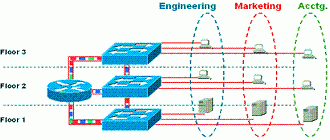Let’s take a look at some technologies that are essential for VLAN implementations.
Inter-Switch Link
Cisco developed the Inter-Switch Link, or ISL, mechanism to support high-speed trunking between switches and switches, routers, or servers in Fast Ethernet environments.
Cisco’s Inter-Switch Link protocol (ISL) enables VLAN traffic to cross LAN segments. ISL is used for interconnecting multiple switches and maintaining VLAN information as traffic goes between switches. ISL uses “packet tagging” to send VLAN packets between devices on the network without impacting switching performance or requiring the use and exchange of complex filtering tables. Each packet is tagged depending on the VLAN to which it belongs.
The benefits of packet tagging include manageable broadcast domains that span the campus; bandwidth management functions such as load distribution across redundant backbone links and control over spanning tree domains; and a substantial cost reduction in the number of physical switch and router ports required to configure multiple VLANs.
The ISL protocol enables in excess of 1000 VLANs concurrently without requiring any fragmentation or re assembly of the packets.
Additionally, ISL wraps a 48-byte “envelope” around the packet that handles processing, priority, and quality-of-service, or QoS, features. ISL is not limited to Fast Ethernet/Ethernet packet sizes (1518 bytes) and can even accommodate large packet sizes up to 16000 bytes — which is appropriate for Token Ring. It is important to understand that ISL (and 802.1q—a format used by some other vendors, for that matter) are both just packet-tagging formats. Neither sets up a standard for administration.
VLAN Standardization
While Cisco was first to market with its revolutionary packet tagging schemes for Fast Ethernet and FDDI, they are proprietary solutions. Other vendors implemented their own unique methods for sharing VLAN information across the network. As a result, a standards body was created within the IEEE to provide one common VLAN communication standard. This ultimately benefits customers using switches from various vendors in the marketplace.
Within the 802.1Q standard, packet tagging is the exchange vehicle for VLAN information.
Because ISL is so widely deployed in our installed customer base, Cisco will continue to support both ISL and 802.1Q. It is important to note that Cisco’s dual mode support of both methods will be implemented via hardware ASICs, which will provide tremendous performance.
VLAN Standard Implementation
This diagram illustrates a typical customer implementation of the 802.1Q VLAN standard. This scenario is based upon a customer network composed of two separate campuses based on different vendors’ technology (Cisco and vendor X).
If the customer already has Cisco switches deployed, it can maintain its use of ISL. Also, it can maintain its use of the VLAN trunking scheme used by vendor X. However, the new joined network must use the 802.1Q standard to share VLAN information between switches within the campus.

